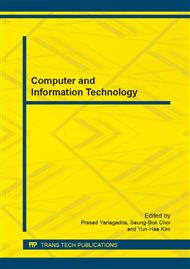[1]
G. Johansson, Visual perception of biological motion and a model for its analysis, Atten. Percept. Psychophysiol. 14 (2) (1973) 201–211.
Google Scholar
[2]
C. BenAbdelkader, R. Cutler, L. Davis, Gait recognition using image self-similarity,J. Appl. Signal Process. (2004) 572–585.
DOI: 10.1155/s1110865704309236
Google Scholar
[3]
J. Hayfron-Acquah, M. Nixon, J. Carter, Automatic gait recognition by symmetry analysis, Pattern Recognit. Lett. 24 (13) (2003) 2175–2183.
DOI: 10.1016/s0167-8655(03)00086-2
Google Scholar
[4]
D. Tao, X. Li, X. Wu, S. Maybank, General tensor discriminant analysis and gabor features for gait recognition, IEEE Trans. Pattern Anal. Mach. Intell. (2007) 1700–1715.
DOI: 10.1109/tpami.2007.1096
Google Scholar
[5]
J. Han, B. Bhanu, Individual recognition using gait energy image, IEEE Trans. Pattern Anal. Mach. Intell. 28 (2) (2006)316–322.
DOI: 10.1109/tpami.2006.38
Google Scholar
[6]
C. Chen, J. Liang, H. Zhao, H. Hu, J. Tian, Frame difference energy image for gait recognition with incomplete silhouettes, Pattern Recognit. Lett. 30 (11) (2009) 977–984.
DOI: 10.1016/j.patrec.2009.04.012
Google Scholar
[7]
K. Bashir, T. Xiang, S. Gong, Feature selection on gait energy image for human identification, IEEE International Conference on Acoustics, Speech and Signal Processing, IEEE, 2008, p.985–988.
DOI: 10.1109/icassp.2008.4517777
Google Scholar
[8]
K. Bashir, T. Xiang, S. Gong, Gait recognition using gait entropy image, 3rd International Conference on Crime Detection and Prevention, IET, 2009, p.1–6.
DOI: 10.1049/ic.2009.0230
Google Scholar
[9]
D. Aha, R. Bankert, A comparative evaluation of sequential feature selection algorithms, Lecture Notes in Statistics, Springer, 1996. 199–206.
DOI: 10.1007/978-1-4612-2404-4_19
Google Scholar
[10]
I. Guyon, A. Elisseeff, An introduction to variable and feature selection, J. Mach. Learn. Res. 3 (2003) 1157–1182.
Google Scholar
[11]
B. Guo, M. Nixon, Gait feature subset selection by mutual information, IEEE Trans. Syst. Man Cybern. Syst. Hum. 39 (1) (2009) 36–46.
DOI: 10.1109/tsmca.2008.2007977
Google Scholar
[12]
J. Doak, An evaluation of feature selection methods and their application to computer security, Tech. Rep., Technical Report CSE-92-18, University of California at Davis, (1992).
Google Scholar
[13]
R. Caruana, D. Freitag, Greedy attribute selection, International Conference on Machine Learning, (1994).
Google Scholar
[14]
S. Yu, D. Tan, T. Tan, A framework for evaluating the effect of view angle, clothing and carrying condition on gait recognition, Pattern Recognit. (2006) 441–444.
DOI: 10.1109/icpr.2006.67
Google Scholar
[15]
S. Chen, H. Zhao, M. Kong, B. Luo, 2D-LPP: a two-dimensional extension of locality preserving projections, Neurocomputing 70(2007) 912–921.
DOI: 10.1016/j.neucom.2006.10.032
Google Scholar


